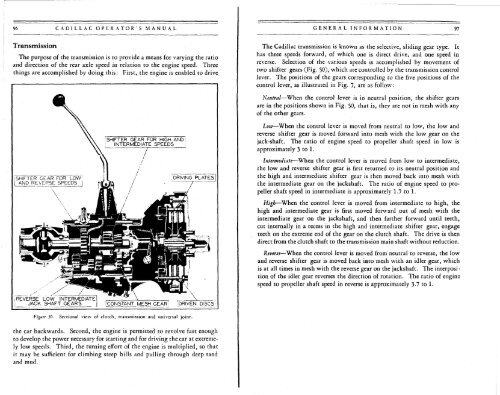1928 Cadillac - GM Heritage Center
1928 Cadillac - GM Heritage Center
1928 Cadillac - GM Heritage Center
You also want an ePaper? Increase the reach of your titles
YUMPU automatically turns print PDFs into web optimized ePapers that Google loves.
96 C A DILL A COPER A TOR'S MANUAL<br />
GENERAL INFORMATION 97<br />
Transmission<br />
The purpose of the transmission is to provide a means for varying the ratio<br />
and direction of the rear axle speed in relation to the engine speed. Three<br />
things are accomplished by doing this: First, the engine is enabled to drive<br />
The <strong>Cadillac</strong> transmission is known as the selective, sliding gear type. It<br />
has three speeds forward, of which one is direct drive, and one speed in<br />
reverse. Selection of the various speeds is accomplished by movement of<br />
two shifter gears (Fig. 50), which are controlled by the transmission control<br />
lever. The positions of the gears corresponding to the five positions of the<br />
control lever, as illustrated in Fig. 7, are as follow:<br />
Neutral—When the control lever is in neutral position, the shifter gears<br />
are in the positions shown in Fig. 50, that is, they are not in mesh with any<br />
of the other gears.<br />
Low—When the control lever is moved from neutral to low, the low and<br />
reverse shifter gear is moved forward into mesh with the low gear on the<br />
jack-shaft. The ratio of engine speed to propeller shaft speed in low is<br />
approximately 3 to 1.<br />
Intermediate—When the control lever is moved from low to intermediate,<br />
the low and reverse shifter gear is first returned to its neutral position and<br />
the high and intermediate shifter gear is then moved back into mesh with<br />
the intermediate gear on the jackshaft. The ratio of engine speed to propeller<br />
shaft speed in intermediate is approximately 1.7 to 1.<br />
High—When the control lever is moved from intermediate to high, the<br />
high and intermediate gear is first moved forward out of mesh with the<br />
intermediate gear on the jackshaft, and then farther forward until teeth,<br />
cut internally in a recess in the high and intermediate shifter gear, engage<br />
teeth on the extreme end of the gear on the clutch shaft. The drive is then<br />
direct from the clutch shaft to the transmission main shaft without reduction.<br />
Reverse—When the control lever is moved from neutral to reverse, the low<br />
and reverse shifter gear is moved back into mesh with an idler gear, which<br />
is at all times in mesh with the reverse gear on the jackshaft. The interposi •<br />
tion of the idler gear reverses the direction of rotation. The ratio of engine<br />
speed to propeller shaft speed in reverse is approximately 3-7 to 1.<br />
Fiptrt 50.<br />
Sectional view of clutch, transmission and universal joint.<br />
the car backwards. Second, the engine is permitted to revolve fast enough<br />
to develop the power necessary for starting and for driving the car at extremely<br />
low speeds. Third, the turning effort of the engine is multiplied, so that<br />
it may be sufficient for climbing steep hills and pulling through deep sand<br />
and mud.
















